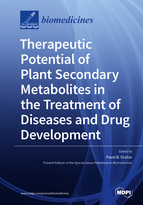Therapeutic Potential of Plant Secondary Metabolites in the Treatment of Diseases and Drug Development
A special issue of Biomedicines (ISSN 2227-9059).
Deadline for manuscript submissions: closed (31 August 2021) | Viewed by 66958
Special Issue Editor
Interests: natural products; isolation; synthetic utilization and analysis
Special Issues, Collections and Topics in MDPI journals
Special Issue Information
Dear Colleagues,
The opportunity to use the vault of natural products, namely, plant secondary metabolites and their semisynthetic derivatives, in the treatment of diseases is becoming more and more exciting. The development of, among others, vector-driven targeted medicinal drugs as well as therapeutic and diagnostic agents based on the structure of biologically active plant secondary metabolites may shorten the development time for new tools, and could make the tools more effective. Similarly, healing instruments developed from this group of bioactive drugs may bring new knowledge. Sometimes, drugs derived from long-used herbal medicines can be more efficient and much safer. On the other hand, the repurposing of already-known APIs from the kingdom of natural products can open new horizons in their study and utilization.
This Special Issue aims to support and highlight the fields of natural products research that uses the plant secondary metabolites either directly or as pharmacophores for the development of tools for diseases recognition, treatment, and possibly even prevention. Contributions from every corner of the plant secondary metabolites field are welcome, but must be based on concrete, chemically well-defined compound(s). We would not object if a new approach to natural products utilization is supported by solid IT tools.
Therefore, I am taking the liberty to invite all authors from the respective fields to contribute with reviews and original research papers. Hand in hand, we will open more possibilities to proceed towards new ways of disease treatment.
Dr. Pavel B. Drašar
Guest Editor
Manuscript Submission Information
Manuscripts should be submitted online at www.mdpi.com by registering and logging in to this website. Once you are registered, click here to go to the submission form. Manuscripts can be submitted until the deadline. All submissions that pass pre-check are peer-reviewed. Accepted papers will be published continuously in the journal (as soon as accepted) and will be listed together on the special issue website. Research articles, review articles as well as short communications are invited. For planned papers, a title and short abstract (about 100 words) can be sent to the Editorial Office for announcement on this website.
Submitted manuscripts should not have been published previously, nor be under consideration for publication elsewhere (except conference proceedings papers). All manuscripts are thoroughly refereed through a single-blind peer-review process. A guide for authors and other relevant information for submission of manuscripts is available on the Instructions for Authors page. Biomedicines is an international peer-reviewed open access monthly journal published by MDPI.
Please visit the Instructions for Authors page before submitting a manuscript. The Article Processing Charge (APC) for publication in this open access journal is 2600 CHF (Swiss Francs). Submitted papers should be well formatted and use good English. Authors may use MDPI's English editing service prior to publication or during author revisions.
Keywords
- plant secondary metabolites
- natural compounds
- drug development
- human diseases treatment
- natural compounds activity mechanisms
- drug repurposing
- drug action modelling







